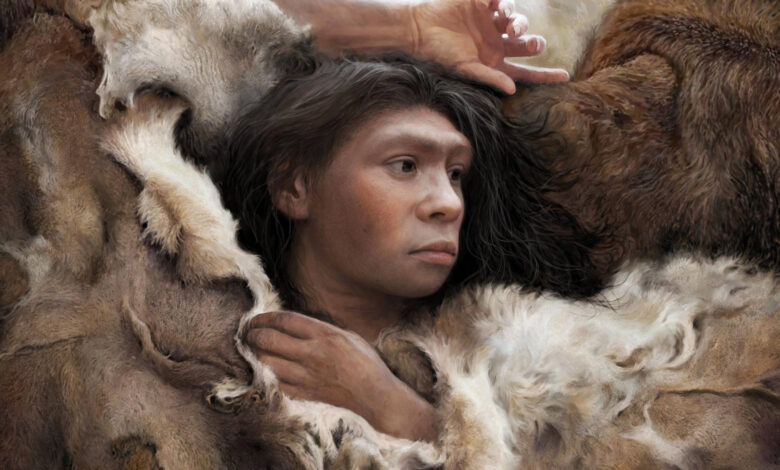
Neanderthals needed strong bodies and the ability to light a fire to withstand the cold climate of northern Europe. But covering them in cold weather is controversial. Evidence indirectly shows that Neanderthals living in cold regions definitely covered themselves from head to toe with animal skins. But so far, no clothes or remains of clothes belonging to Neanderthals have been discovered.
Kara Okobok“Unfortunately, we’ll probably never find archaeological evidence of Neanderthal clothing,” anthropologist from the University of Notre Dame told LiveScience. “These things are not well maintained.”
Humans adapted to the cold
Neanderthals once lived throughout Eurasia, as far north as Siberia. Broad chests, large noses, shoulders, and hips, along with short limbs, helped our closest early relatives conserve body heat in cold climates.
“I think of them as the defensive linemen of human evolution,” Okobok says. One of the ways to support the strong body structure of the Neanderthals was to eat a lot of meat, which also increased their body heat. Neanderthals could also keep themselves warm by being physically active and sitting by the fire when resting.
But Okobok adds, “They definitely needed an extra protective barrier on their skin to maintain their internal body temperature.” “I wouldn’t be surprised if they used a variety of covers for the face, head, arms, thighs, hands and feet.”
Evidence of wearing clothes
Despite the discovery of evidence of clothing from early wise men, such as the Iceman’s 5,000-year-old Otsi leather suit, no similar evidence has yet been found at Neanderthal archaeological sites.
So far, no evidence of clothing has been discovered in Neanderthal archaeological sites
However, there is circumstantial evidence: a stone scraper found at the Neumark Nord archaeological site in Germany contained small amounts of sediment that may have been stuck to it 200,000 years ago when animal hides were processed. These sediments contained acid from oak tree bark, which could have been used for tanning and preserving animal skin. However, it is not precisely known whether these deposits came from the production of clothing or from the manufacture of fur and skin coverings for bedding.
Also, stone and bone pins discovered at a Neanderthal archaeological site in central France show that these early humans made tools specifically for attaching skins together to make clothing or shelter.
The genetics of head and body lice also show that Neanderthals and wise man (Homo sapiens) separated from each other about 170,000 to 72,000 years ago. Approximately 100,000 years ago, a type of body louse was retransmitted from another ancient human population (probably the Neanderthals) to the wise man. Since body lice live on clothes, this suggests that our ancestors started wearing clothes a little earlier.
read more
The front teeth of all Neanderthals were much more worn than their back teeth, indicating that they used their mouths not only for eating, but also for holding and manipulating objects. Tooth wear in Neanderthals is similar to the contemporary Inuit people (indigenous Eskimos of northern Canada and Greenland) who used their teeth to soften animal skins to make clothing.
The oldest direct evidence of Neanderthal fiber technology is a piece of three-ply rope attached to a stone tool at an archaeological site in southeastern France, dating to between 41,000 and 52,000 years old. Although ropes and twines can be used to make nets, baskets and traps, they can also be made into shoes and cloth.
There are no traces of frostbite in Neanderthal skeletons
according to Sera Laceya biological anthropologist from the University of Delaware, another research topic that has not yet been well explored is the evidence of frostbite in Neanderthals. Frostbite can be a problem even for modern humans living in polar regions.
“If Neanderthals didn’t wear clothes, shouldn’t we expect them to have lost their fingers, toes, and noses?” Lacey says. Okobok notes that Neanderthals probably protected their genitals from the cold with a type of Neanderthal scrotum. “If the penis fell off, they’d be done,” he says.
Therefore, the absence of any widespread traces of frostbite in Neanderthal skeletons adds to the evidence of the theory of body protection against cold. They must have protected their hands and feet from the cold.
Neanderthal fashion
Although most researchers agree that Neanderthals wore clothing, the type of clothing they wore is still debated. In the past, scientists thought that Neanderthals wore simple clothing such as lounging cloth or loose cloaks. But Lacey believes that due to the intelligence of Neanderthals, they are being underestimated.
Looking at modern-day Inuit clothing, which includes a parka (a type of warm coat), pants, and boots, Lacey speculates that Neanderthal men and women may have had similar clothing, although women’s clothing may have been adapted to pregnancy. , was a little wider. Neanderthal infants were also likely wrapped in animal skins when not near their caregivers.
“All the hominids that lived above 40 degrees latitude (about present-day Madrid) were probably our first fashionistas,” Lacey says. It makes sense that these people are also clothing innovators.”








